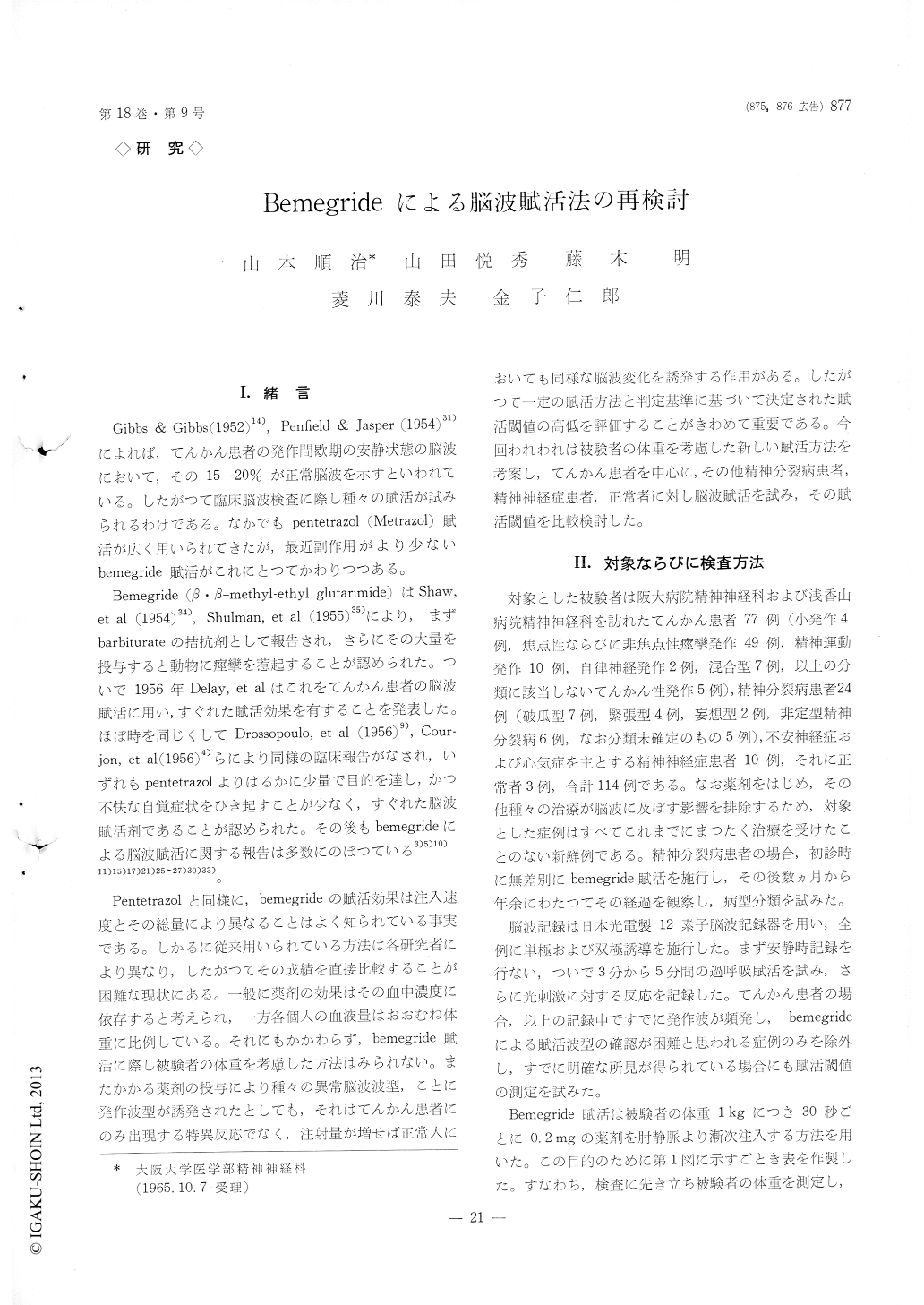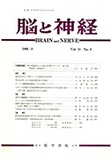Japanese
English
- 有料閲覧
- Abstract 文献概要
- 1ページ目 Look Inside
I.緒言
Gibb & Gibbs (1952)14),Penfenfield&Jasper (1954)31)によれば,てんかん患者の発作間歇期の安静状態の脳波において,その15-20%が正常脳波を示すといわれている。したがつて臨床脳波検査に際し種々の賦活が試みられるわけである。なかでもpentetrazol (Metrazol)賦活が広く用いられてきたが,最近副作用がより少ないbemegride賦活がこれにとつてかわりつつある。
Bemegride (β・β—methyl-ethyl glutarimide)はShaw, et al (1954)34), Shulman, et al (1955)35)により,まずbarbiturateの拮抗剤として報告され,さらにその大量を投与すると動物に痙攣を惹起することが認められた。ついで1956年Delay, et alはこれをてんかん患者の脳波賦活に用い,すぐれた賦活効果を有することを発表した。ほぼ時を同じくしてDrossopoulo, et al (1956)9), Cour—jon, et al (1956)4)らにより同様の臨床報告がなされ,いずれもpentetrazolよりはるかに少量で目的を達し,かつ不快な自覚症状をひき起すことが少なく,すぐれた脳波賦活剤であることが認められた。その後もbemegrideによる脳波賦活に関する報告は多数にのぼつている3)5)10)11)15)17)21)25)27)30)33)。
Since the introduction by Delay (1956), bemegride has been widely used as an activating substance in the EEG examination of epileptics. Earlier workers adopted methods of injecting at a constant speed re-gardless of the body weight of the subject, although the activating action of the drug is closely related to its injection speed and total dose. In the present work, was adopted a new method of injecting 0.2mg/ kg of bemegride intravenously every 30 sec. up to the maximum dose of 4.0 mg/kg. The injection was stopp-ed when a generalized irregular spike and wave burst or high voltage slow burst was induced in the EEG tracings. The threshold was determined by the amount of the drug injected up to these EEG paro-xysmal changes.
Subjects were 77 epileptics, 24 schizophrenics, 10 psychoneurotics, and 3 normal adults. None of them received medical treatment prior to the present exam-nation.
Results :
(1) Range and mean value of the bemegride thres-hold in the various clinical groups were as follows ; 0.3-4.0 mg/kg, mean 1.3 mg/kg (S. D. 0.8) in epileptics, 0.9-4.0 mg/kg, mean 2.9 mg/kg (S. D. 1.0) in schizophrenics, 2.1-3.1 mg/kg, mean 2.5 mg/kg (S. D. 0.3) in psychoneurotics and 2.4 -2.6 mg/kg, mean 2.5 mg/kg (S. D. 0.1) in normal subjects.
(2) The threshold in "sleep epileptics (Janz)" was considerably higher than the other epileptics ("epi-leptics on awakening " and "diffuse epileptics" according to Janz) ; 2.3-4.0 mg/kg, mean 3.0 mg/kg (S. D. 0.7) in " sleep epileptics " and 0.3 -2.2 mg/kg, mean 1.1 mg/kg (S. D. 0.5) in the other epileptics. From above reason, the data in " sleep epileptics " were excluded from the follow-ing analysis.
(3) In 96% of the epileptics other than sleep epilep-tics, the threshold was 2.0 mg/kg or less. And in 59% of them it was 1.0 mg/kg or less.
(4) No considerable difference between the thresholds of groups of epileptics classified with regards to the characteristics in the resting EEG (normal group, mean, 1.3 mg/kg, S. D., 0.7 ; borderline group, mean, 1.2 mg/kg, S. D., 0.3 ; abnormal group, mean, 1.0 mg/kg, S. D., 0.4).
(5) No significant difference between the mean thres-hold values of focal (0.4-2.2 mg/kg, mean 1.1 mg/kg, S. D. 0.5) and of non-focal (0.3-1.9 mg/kg, mean 0.9 mg/kg, S. D. 0.4) epileptics.
(6) No significant relationship between the threshold and the frequency of attacks.
(7) No statistically significant threshold difference with Age or with Sex.
(8) Seventeen epileptics who were completely seizure-free for 3-11 months by medication of anticon-vulsant were reexamined by bemegride activation. Practically no significant change in the threshold value was found after medication with diphenyl-hydantoin, while trimethadion and phenobarbital raised it considerably (more than 2 times).
(9) In 11 cases (14%) of epileptics, clinical attacks were induced. Ten of them reproduced their own habitual seizure.
(10) A significantly lower threshold in the atypical schizophrenics (mean 2.0 mg/kg) than that in the typical group ; a considerably higher threshold in hebephrenics (mean 3.9 mg/kg).
(11) Psychoneurotics (mainly anxiety neurosis and hy-pochondria) and normal subjects had the same mean threshold value (2.5 mg/kg).
(12) In 7 cases (70%) of psychoneurotics, generalized convulsive attack was induced during examination. In these instances, the initial EEG paroxysmal discharge appeared almost simultaneously with the onset of the clinical attack.

Copyright © 1966, Igaku-Shoin Ltd. All rights reserved.


